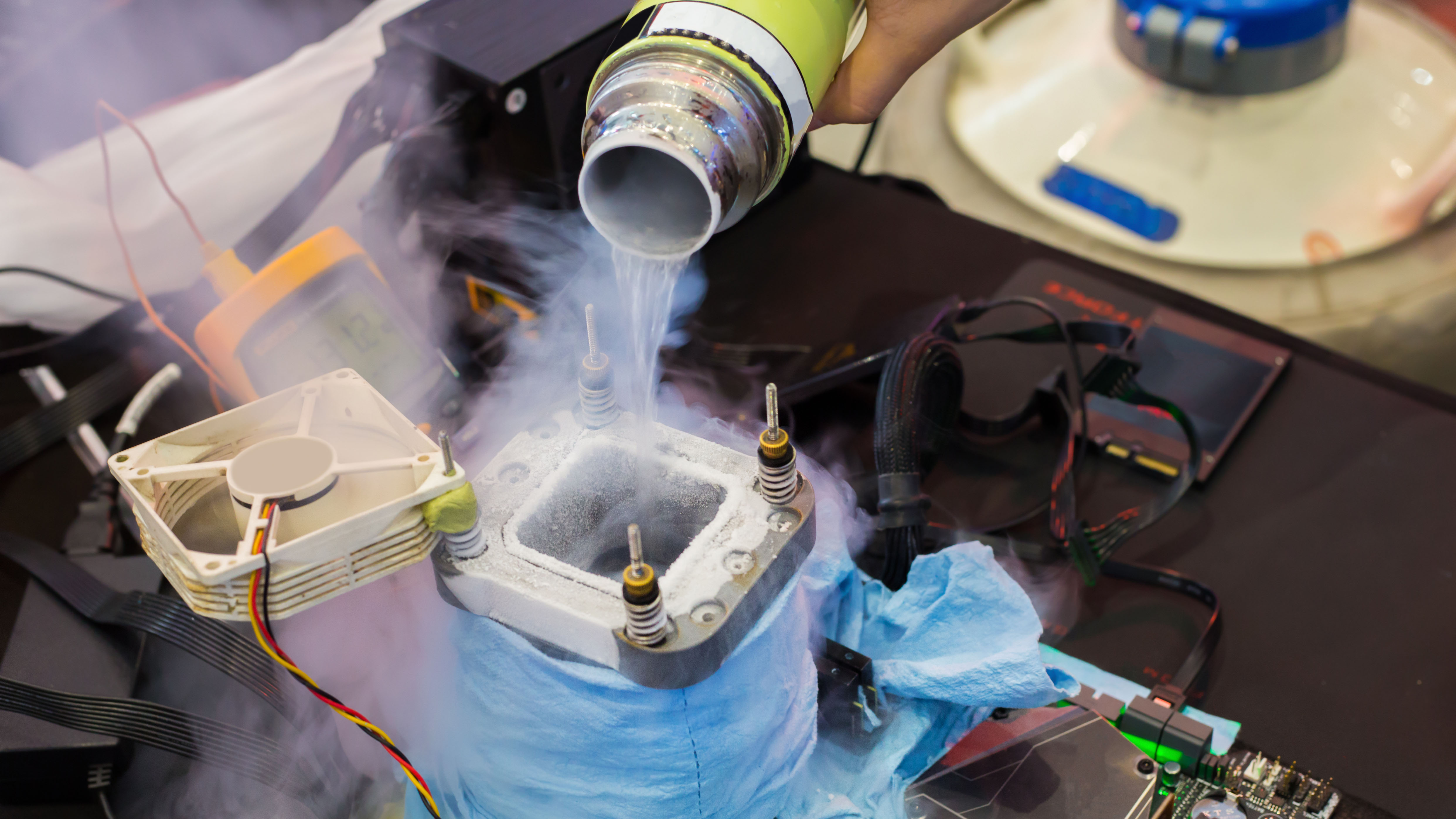6.3 GHz Ryzen 9 9700X beats 7.1 GHz Core i9-14900KF in liquid nitrogen AVX showdown
AVX-512 enables Zen 5 to outperform Raptor Lake in AVX-focused testing, even with a 800MHz deficit in clock speed.

LN2 overclocker Skatterbencher has taken AMD's Ryzen 7 9700X to new heights, beating a 7.1GHz Core i9-14900KF in OCCT with nearly a 1 GHz deficit clock speed. The overclocker broke the OCCT AVX benchmark world record with a score of 269.35 points on AMD's latest Zen 5 8-core chip.
The world record-breaking result was achieved at just 6.318 GHz on the Ryzen 7 9700X. To get the Zen 5 chip to that speed, SkatterBencher used a host of techniques, rather than inputing a manual multiplier and voltage. Skatterbencher used a combination of BCLK overclocking, Precision Boost Overdrive, AMD's Curve Optimizer (with a positive offset), and Curve Shaper to enable Ryzen's Precision Boost algorithm to run at well over 6GHz on liquid nitrogen.
With a score of 269.35 points, the Ryzen 7 9700X outscored Intel's flagship Core i9-14900KF in the same benchmark, clocked at 7.1GHz on liquid nitrogen. The Core i9's score was 14 points lower than the Zen 5 equivalent, despite operating at an 800MHz higher clock speed.
However, in the SSE version of the benchmark, the 9700X wasn't as strong. In OCCT's SSE benchmarks, the 9700X was not able to outperform the 14900KF, featuring a score of 127.79 points, 8.76 points behind the Raptor Lake CPU.
In other benchmarks, the Ryzen 7 9700X was able to reach 1,003 points in CPU-Z 2017.1's single-core benchmark and 10,805 points in the multi-core counterpart. Skatterbencher was also able to push the 9700X to 6.8GHz by disabling SMT, enabling the 9700X to hit the highest CPU frequency on the CPU-Z validator over the last 12 months. In Geekbench 6, SkatterBencher was able to hit a single core result of 3,902 points and a multi-core result of 21,135 points at 6.3 GHz.
SkattterBencher's LN2 scores show the strengths of AMD's Zen 5 architecture, namely its beefier AVX-512 optimizations. Zen 5 is the first AMD architecture to boast a full throughput AVX-512 pipeline, boosting AVX-512 performance over Zen 4. Intel on the other hand does not have any AVX-512 support on its 13th or 14th Gen chips, relegating the i9-14900KF to using AVX and/or AVX2 instructions for the OCCT test. This is most certainly the reason why the 9700X was able to outpace the i9-14900KF at such a severe clock speed disadvantage.
Get Tom's Hardware's best news and in-depth reviews, straight to your inbox.

Aaron Klotz is a contributing writer for Tom’s Hardware, covering news related to computer hardware such as CPUs, and graphics cards.
-
Amdlova Some guys just want a htpc and never listen something from it.Reply
Other guys think a 360 rad is a good thing.
And have the LN2 people who got money to make incredible news, Who no one can use... -
emike09 AVX512 will always outperform AVX2 if written properly and used in the right scenario. IPC being the same, Intel's 13/14th Gen's lack of AVX512 will obviously fail here due to the lack of AVX512 support on consumer chips. Benchmark against Intel's latest overclockable workstation Xeon CPUs and the story could be very different. This is a terrible comparison article and reads out as fanboy-ism for AMD.Reply
Intel dropped AVX512 from consumer CPUs for good reason. Consumers and most power users don't use AVX512. AVX-512 was designed to enhance performance for certain high-performance computing and server applications. For consumers, it's a waste of silicon, adds complexity to design, runs hot, and increases development cost.
Intel's decision to drop AVX512 from consumer chips was a strategic one, aiming to balance silicon space, performance, power efficiency, and cost considerations while targeting the needs of the broader consumer market. Given the limited use case in consumer applications, the development costs associated with integrating and supporting AVX-512 outweighs the benefits for the consumer market. -
bit_user Reply
The problem with this logic is that AVX10.1 incorporates all of the AVX-512 instructions that were natively implemented in Golden Cove, and that is coming to consumer CPUs. So, it's not as if Intel actually doesn't want to give consumers those capabilities. The problem is with the maximum vector width (i.e. 512-bit), which would seriously undermine their E-core strategy.emike09 said:Intel dropped AVX512 from consumer CPUs for good reason. Consumers and most power users don't use AVX512. AVX-512 was designed to enhance performance for certain high-performance computing and server applications. For consumers, it's a waste of silicon, adds complexity to design, runs hot, and increases development cost.
https://www.phoronix.com/news/Intel-AVX10
As for the general applicability of AVX-512, it has features which make it much better for auto-vectorization, such as per-lane predication. Lately, a trend seems to be for people to use it in acceleration of string operations and other sorts of generic computation:emike09 said:Given the limited use case in consumer applications, the development costs associated with integrating and supporting AVX-512 outweighs the benefits for the consumer market.
https://www.phoronix.com/review/simdjson-avx-512 https://www.phoronix.com/news/Intel-AVX-512-Quicksort-Numpy https://www.phoronix.com/news/Intel-Bit-Count-AVX-512-Postgre
Not surprisingly, it's even good for video processing and encoding:
https://www.phoronix.com/news/FFmpeg-Ripe-For-More-AVX-512
As mentioned above, the development costs for AVX10 will be the same - and that's definitely coming to client CPUs. So, it's not a case that it doesn't make sense - just that they went too far in making it 512-bit. -
The Historical Fidelity Reply
It seems that Intel’s AVX-512 architectural layout had a major fault, it ran so hot that Intel had to create a downclock offset whenever it is being used. AMD’s version does not have this problem. Perhaps when Intel reintroduces 512-bit vector compute with AVX10, their redesigned logic will not suffer the same problem.emike09 said:AVX512 will always outperform AVX2 if written properly and used in the right scenario. IPC being the same, Intel's 13/14th Gen's lack of AVX512 will obviously fail here due to the lack of AVX512 support on consumer chips. Benchmark against Intel's latest overclockable workstation Xeon CPUs and the story could be very different. This is a terrible comparison article and reads out as fanboy-ism for AMD.
Intel dropped AVX512 from consumer CPUs for good reason. Consumers and most power users don't use AVX512. AVX-512 was designed to enhance performance for certain high-performance computing and server applications. For consumers, it's a waste of silicon, adds complexity to design, runs hot, and increases development cost.
Intel's decision to drop AVX512 from consumer chips was a strategic one, aiming to balance silicon space, performance, power efficiency, and cost considerations while targeting the needs of the broader consumer market. Given the limited use case in consumer applications, the development costs associated with integrating and supporting AVX-512 outweighs the benefits for the consumer market. -
Hotrod2go Funny how in light of this article, Zen 5 is often cited in the tech media as a "failed" launch... :ROFLMAO:Reply -
bit_user Reply
That's because Intel introduced it at 14 nm. People tested Intel's implementation in Alder Lake (back when you still could) and found neither a significant clock penalty, nor excessive temperatures. 14 nm was just too soon to introduce it into a high-clocking CPU (though fine for Xeon Phi, which only boosted up to 1.7 GHz (1.5 GHz base)).The Historical Fidelity said:It seems that Intel’s AVX-512 architectural layout had a major fault, it ran so hot that Intel had to create a downclock offset whenever it is being used. AMD’s version does not have this problem.
https://www.phoronix.com/review/alder-lake-avx512
IMO, the main thing AMD got right was to wait until TSMC N5 to do it. Sure, they also had half the FMA ports and everything in their backed basically retained the same widths as Zen 3.
In the N4P-based Zen 5 (desktop/server), not only did they double the width of the pipes, but they also doubled the number of FMA ports, to equal Golden Cove Server's AVX-512 pipeline arrangement.
Compare to:
https://chipsandcheese.com/2023/03/12/a-peek-at-sapphire-rapids/
Lion Cove already increased the FP pipelines by 33%. It'd be interesting if their first core to implement AVX10/256 had double the issue ports at half the width of their Golden Cove server cores.The Historical Fidelity said:Perhaps when Intel reintroduces 512-bit vector compute with AVX10, their redesigned logic will not suffer the same problem. -
Rdslw Reply
you can use it a bit, as leaders in LN2 also do best in regular overclocking, at least with 9700x you can shove 170W on it, slap 360 AIO, and enjoy really nice performance for low cost.Amdlova said:Some guys just want a htpc and never listen something from it.
Other guys think a 360 rad is a good thing.
And have the LN2 people who got money to make incredible news, Who no one can use...
7700x works even better if you dont OC the hell of out of them
if we ever see them that is. Release date is always in the classic forever "tomorrow" scenario.bit_user said:Lion Cove already increased the FP pipelines by 33%. It'd be interesting if their first core to implement AVX10/256 had double the issue ports at half the width of their Golden Cove server cores. -
bit_user Reply
Lunar Lake uses Lion Cove and begins shipping in exactly 1 week. Its paper launch was 2 weeks ago.Rdslw said:if we ever see them that is. Release date is always in the classic forever "tomorrow" scenario. -
jeremyj_83 I didn't see it in the article nor while skimming the video. Was it mentioned if the e-core on the 14900KS were still enabled? Gracemont e-core have AVX2 and even if they were only at base clock that still would give the 14900KS an extra 16 cores to crunch AVX2 instructions. That means that if they were enabled the AVX512 in Zen 5 is MUCH faster than AVX2 in Raptor/Gracemont.Reply -
rluker5 I'm surprised nobody brought up how the 9700x also beats the 14900kf in igpu benches ;pReply
